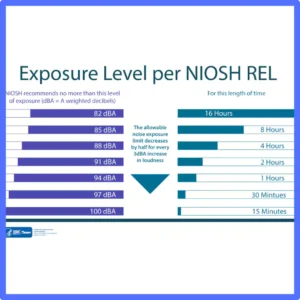Protecting Your Hearing at Work: Understanding Occupational Hearing Loss
Occupational hearing loss is a leading work-related illness in the United States. Exposure to loud noise or harmful chemicals at work can permanently damage your hearing. Fortunately, with proper precautions, occupational hearing loss is preventable.
What Causes Occupational Hearing Loss?
Hearing damage at work happens in three main ways:

- Repeated Noise Exposure: Consistent exposure to sounds at 85 dBA or higher can cause gradual damage over time. This type of exposure is common in industries like manufacturing, construction, and agriculture. The damage happens slowly, making it harder to notice until significant hearing loss has occurred.
- Examples of harmful noise include machinery hum, power tools, and vehicle engines.
- The allowable exposure time is cut in half for every 3 dBA increase in sound level. For instance, you can safely listen to an 85 dBA sound for 8 hours, but at 88 dBA, safe exposure drops to 4 hours.
- Sudden Loud Sounds: Exposure to an extremely loud noise, even for a short duration, can cause immediate hearing loss. This is known as acoustic trauma.
- Examples include explosions, gunshots, or sudden blasts of machinery.
- Immediate hearing loss may also cause tinnitus, or ringing in the ears, which can last permanently.
- Ototoxic Chemicals: Certain chemicals can damage the delicate structures of the ear, especially when combined with noise exposure. These chemicals are found in:
- Solvents like toluene, xylene, and styrene used in painting, printing, or plastics.
- Heavy metals such as lead and mercury used in manufacturing.
- Pesticides and other industrial chemicals.
Combining noise and ototoxic chemicals increases the risk of hearing damage. Workers in agriculture, automotive, and chemical processing industries should take special precautions.
Learn how these dangers are causing hearing loss in younger generations.
How Loud is Too Loud? Understanding Noise Levels
Noise levels are measured in decibels (dBA). Prolonged exposure to any sound at or above 85 dBA can cause hearing loss.
Key Noise Levels to Know:
- 85 dBA: Safe for up to 8 hours, but prolonged exposure can still cause damage.
- Examples: Heavy traffic, power tools, lawnmowers.
- If you need to raise your voice to talk to someone 3 feet away, the noise is likely around 85 dBA.
- 90-95 dBA: Risk increases with exposure over just 1-2 hours.
- Examples: Bulldozers, chain saws, and factory machinery.
- At this level, shouting is required to communicate with someone close by.
- 100+ dBA: Damage can occur within minutes.
- Examples: Firearms, ambulance sirens, rock concerts, and jackhammers.
- Ears may feel muffled, ring, or ache after exposure to these noise levels.
Signs That Noise Levels Are Too High:
- You experience ringing in your ears or muffled hearing after leaving a noisy area.
- You need to turn up the radio or phone volume after a work shift.
- You feel discomfort or pain in your ears when exposed to loud noise.
Understanding the Time-Intensity Relationship
The louder the noise, the shorter the time you can safely tolerate it:
- 85 dBA: 8 hours
- 88 dBA: 4 hours
- 91 dBA: 2 hours
- 94 dBA: 1 hour
- 97 dBA: 30 minutes
This relationship highlights why constant exposure in noisy workplaces requires proper hearing protection.
Industries with High Hearing Loss Risks
Workers in certain fields are more vulnerable to occupational hearing loss:
- Construction Workers: Tools like jackhammers and drills create dangerous noise levels.
- Factory Workers: Manufacturing environments are consistently noisy.
- Farmers: Tractors, machinery, and open cabs contribute to hearing loss.
- Musicians: Regular exposure to loud music, whether live or in rehearsal spaces.
- Entertainment Venue Staff: Arenas and stadiums often exceed safe noise levels.
- Dental Professionals: High-speed dental drills can cause high-frequency hearing damage.
Regardless of industry, noise exposure risks exist everywhere. Employers must monitor noise levels and provide hearing protection.
Signs of Occupational Hearing Loss
Recognizing early symptoms of hearing damage is crucial:
- Difficulty hearing conversations in noisy environments.
- Constantly asking others to repeat themselves.
- Thinking people are mumbling when they speak.
- Ringing or buzzing in your ears (tinnitus).
Your friends or family may notice your hearing issues before you do. If you experience these symptoms, schedule a hearing evaluation immediately.
Find out more about the signs of hearing loss.
Health and Safety Impacts of Hearing Loss
Hearing loss affects more than just communication. It can impact your overall well-being and safety:
- Mental Health: Hearing loss is linked to depression, anxiety, and feelings of isolation.
- Cognitive Decline: Research connects untreated hearing loss to a faster decline in brain function.
- Heart Health: Noise exposure can increase stress levels, blood pressure, and heart disease risks.
- Safety Risks: Hearing loss can make it difficult to hear alarms, vehicles, or machinery.
For pregnant workers, excessive noise can also harm the baby’s development and hearing.
Preventing Occupational Hearing Loss
Both employers and workers play a role in hearing loss prevention. Follow these key steps:
For Employers:
- Monitor Noise Levels: Use sound level meters to measure workplace noise.
- Reduce Noise: Use quieter equipment or isolate noisy machinery.
- Establish Hearing Conservation Programs: Offer regular hearing tests and protective gear.
- Provide Hearing Protection: Supply properly fitting earplugs or earmuffs.

For Workers:
- Wear Hearing Protection: Use earplugs or earmuffs in noisy areas.
- Limit Noise Exposure: Take regular breaks away from loud environments.
- Monitor Chemicals: Avoid ototoxic chemicals or wear appropriate protective equipment.
- Test Your Hearing Annually: Regular hearing tests help detect changes early.
Discover all about hearing tests.
Simple Steps to Protect Your Ears
Protecting your hearing is easier than you think. Follow these tips:
- Take breaks in quiet areas throughout the day.
- Reduce the volume of personal devices like headphones.
- Maintain a safe distance from loud equipment.
- Use hearing protection consistently and correctly.
Preventing hearing loss starts with awareness and action. Speak with your employer about hearing safety programs and protective measures.
Why Occupational Hearing Loss Matters
Hearing loss can impact your ability to perform well at work and enjoy daily life. Untreated hearing loss can lead to lower income, employment challenges, and reduced quality of life. Protecting your hearing today helps safeguard your future.

Get Your Hearing Checked Today
If you work in a noisy environment, don’t wait until hearing loss becomes noticeable. Contact Stanford Hearing today to schedule a comprehensive hearing evaluation. Protect your hearing for years to come.
